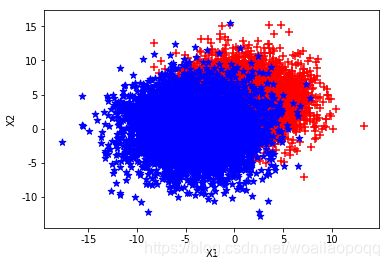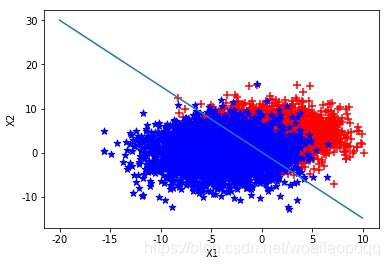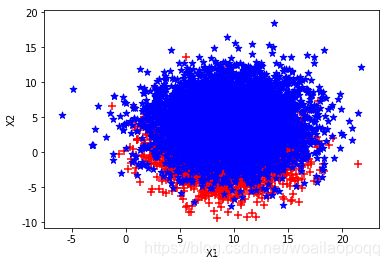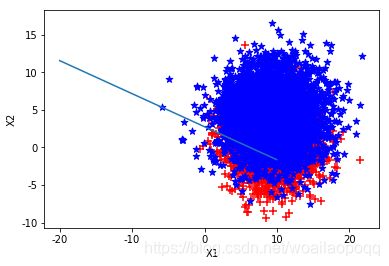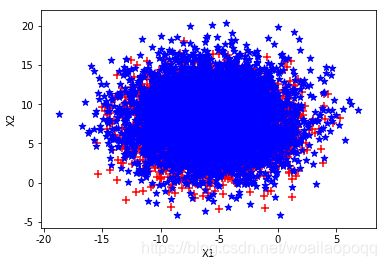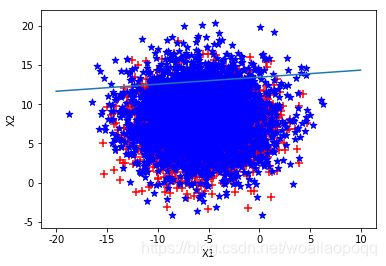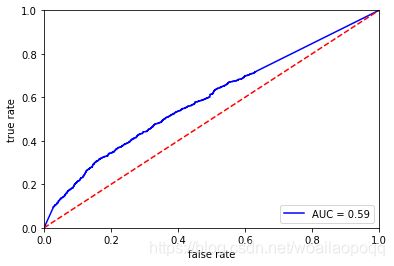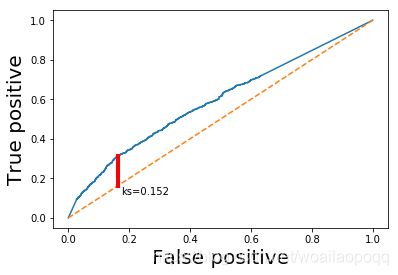逻辑回归(ROC、AUC、KS)-python实现-内含训练数据-测试数据
一、逻辑回归理论:关注代码上线
Hypothesis Function(假设函数):1.0/(1+exp(-inX))
![]()
Cost Function(代价函数):
![]()
![]()
通过梯度下降法,求最小值。
weights(系数矩阵)=weights+alpha(固定值)*dataMatrix(特征指标)*error(真实值-预测值)
二、运行效果
第一组:
第二组:
第三组:
三、python代码实现-梯度上升
import matplotlib.pyplot as plt
import numpy as np
from numpy import exp
from sklearn.metrics import confusion_matrix
from sklearn.metrics import roc_curve, auc
import pandas as pd
import matplotlib.pyplot as plt #导入图像库
import matplotlib
import seaborn as sns
import statsmodels.api as sm
from sklearn.metrics import roc_curve, auc
import math
from sklearn import metrics
from sklearn.datasets import make_classification
from sklearn.datasets import make_blobs
from sklearn.datasets import make_gaussian_quantiles
from sklearn.datasets import make_hastie_10_2
from sklearn.model_selection import train_test_split
#假设函数
def sigmoid(inX):
return 1.0/(1+exp(-inX))
#获取预测Y值,系数为weights
def getValue(x,weights):
return (weights[0, 0] - weights[1, 0] * x) / weights[2, 0]
#梯度上升方法求Cost Function
def grad_descent(Xtrain,alpha,max_cycle):
#划分训练数据,测试验证数据
Y=Xtrain['y']
#训练X
X=Xtrain[['x0','x1','x2']]
dataMatrix = np.mat(X).T #(m,n)
dataMatrix_sigmoid = np.mat(X)
labelMat = np.mat(Y).T
m,n = np.shape(X)
weights = np.ones((n, 1)) #初始化回归系数(n, 1)
# print('weights:\n',weights)
for i in range(max_cycle):
h = sigmoid(dataMatrix_sigmoid * weights) #sigmoid 函数
error=labelMat-h
weights=weights+alpha*dataMatrix*error
#绘制二分类图使用t_为Y=1,f_为Y=0
t_x1=Xtrain.loc[(Xtrain['y']==1)]['x1']
t_x2=Xtrain.loc[(Xtrain['y']==1)]['x2']
f_x1=Xtrain.loc[(Xtrain['y']==0)]['x1']
f_x2=Xtrain.loc[(Xtrain['y']==0)]['x2']
fig = plt.figure()
ax = fig.add_subplot(111)
#y=1的点
ax.scatter(f_x1,f_x2,marker='+',label='1',s=50,c='r')
#y=0的点
ax.scatter(t_x1,t_x2,marker='*',label='1',s=50,c='b')
"""
参数个数情况: np.arange()函数分为一个参数,两个参数,三个参数三种情况
1)一个参数时,参数值为终点,起点取默认值0,步长取默认值1。
2)两个参数时,第一个参数为起点,第二个参数为终点,步长取默认值1。
3)三个参数时,第一个参数为起点,第二个参数为终点,第三个参数为步长。其中步长支持小数
"""
# print('weights:\n',weights)
x = np.arange(-20, 10, 0.05)
y = -(weights[0, 0] +weights[1, 0] * x) / weights[2, 0] #matix
ax.plot(x, y)
plt.xlabel('X1')
plt.ylabel('X2')
plt.savefig('image.png')
plt.show()
return weights
def init_data(data_file_name,init_random_state,length):
#生成二分类数据,根据参数不同,生成的数据分类也不同,可以观察实际效果,最终ROC、KS都有变化
randam_data, randam_target = make_blobs(n_features=2, n_samples=length, centers=2, random_state=init_random_state, cluster_std=[3,3.5])
df = pd.DataFrame(randam_data,randam_target)
df['target'] = randam_target
df['x0']=1
df.columns = ['x1','x2','y','x0']
df.to_csv(data_file_name,index=False)
df1 = df[df['y']==0]
df2 = df[df['y']==1]
df1.index = range(len(df1))
df2.index = range(len(df2))
fig = plt.figure()
ax = fig.add_subplot(111)
ax.scatter(df1['x1'],df1['x2'],marker='+',label='1',s=50,c='r')
ax.scatter(df2['x1'],df2['x2'],marker='*',label='1',s=50,c='b')
plt.xlabel('X1')
plt.ylabel('X2')
plt.savefig('image.png')
plt.show()
def run(index):
data_file_name = 'logistic_regression_data'
file_name = data_file_name+'_'+str(index)+'.csv'
init_data(file_name,index+1,10000)
data = pd.read_csv(file_name)
Xtrain, Xtest, Ytrain, Ytest = train_test_split(data,data['y'],test_size=0.3)
weights = grad_descent(Xtrain,0.01,10000)
#测试集进行验证
w=weights[0, 0]*Xtest['x0']+weights[1, 0]*Xtest['x1']+weights[2, 0]*Xtest['x2']
sm_y_probability = sigmoid(w)
sm_y_pred = np.where(sm_y_probability >= 0.5,1,0)
# cm = confusion_matrix(Xtest['y'],sm_y_pred,label=[0,1])
fpr,tpr,threshold = metrics.roc_curve(Ytest,sm_y_probability)
#计算ROC,并绘制曲线
rocauc = auc(fpr, tpr)
plt.plot(fpr, tpr, 'b', label='AUC = %0.2f' % rocauc)
plt.legend(loc='lower right')
plt.plot([0, 1], [0, 1], 'r--')
plt.xlim([0, 1])
plt.ylim([0, 1])
plt.ylabel('true rate')
plt.xlabel('false rate')
plt.show()
ks_value = max(abs(fpr-tpr))
#ROC曲线
plt.plot(fpr, tpr)
plt.plot([0,1], [0,1], linestyle='--')
#绘制KS
x = np.argwhere(abs(fpr-tpr) == ks_value)[0, 0]
plt.plot([fpr[x], fpr[x]], [fpr[x], tpr[x]], linewidth=4, color='r')
plt.text(fpr[x]+0.01,tpr[x]-0.2, 'ks='+str(format(ks_value,'0.3f')),color= 'black')
plt.xlabel('False positive', fontsize=20)
plt.ylabel('True positive', fontsize=20)
plt.show()
def main():
#数据格式 x0|x1|x2|y,其中x0列为1,程序自动生成训练的数据
run(2)
run(3)
run(4)
run(5)
run(6)
if __name__ == '__main__':
main()
